Autonomous vehicles (AVs) will shape urban policy in the coming decade and beyond, bringing benefits, risks, and unintended consequences as they become more widely used in cities. A new initiative from the Aspen Institute and Bloomberg Philanthropies will address these implications in cities in the US and across the world. The initiative just released a report detailing how autonomous vehicles may affect urban areas — below are seven potential policy areas that should be on the minds of city officials as they prepare for the rise of AVs.
Road Safety
Advocates for autonomous vehicles make big promises about highway safety, but how would AVs reduce risks on city streets? Here’s one example: In wealthy nations, decades of safety gains are at risk from the recent rise of distracted driving. In the United States, deaths spiked by more than 10 percent in 2016.
Can driverless cars be a panacea for distracted driving? They can respond to an emergency as much as six times faster. They can also be programmed to try to avoid accidents. But other research shows that partial AVs will make distracted driving worse by lulling drivers into complacency. And other questions remain. What testing protocols must cities put in place? And do they have the necessary authority to do what’s needed to enforce safety standards?
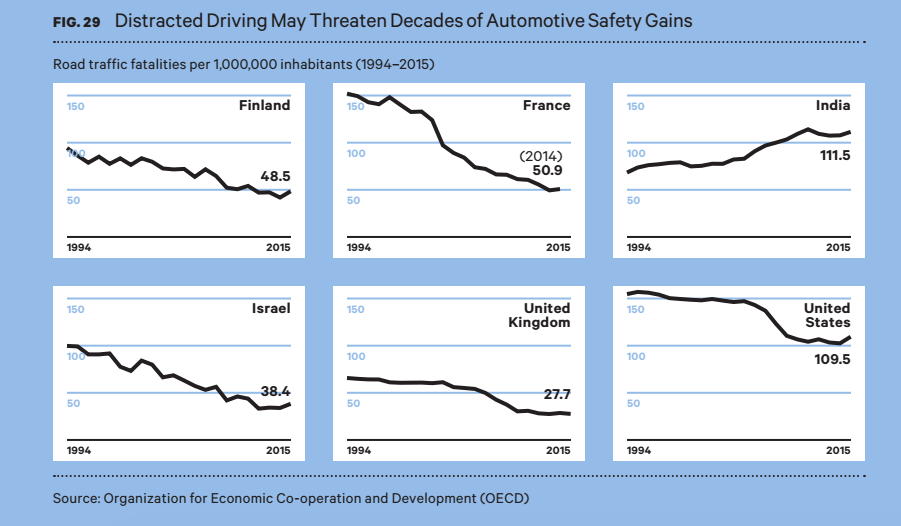
Mobility
Ride sharing is another potential horizon for urban AVs. In this scenario, shared electric AVs (dubbed “taxibots” by the OECD) could displace most private cars from cities by 2030. How would this work? It would depend on the creation of a virtuous cycle of falling costs and rising ridership, enabled by automation.
Existing ride-share services like Lyft Line and uberPOOL have shown that a market exists for cheaper taxi trips. As automation drives fares for shared rides even lower, this market will expand. Taxibots could prove to be extensions of transit systems, much like today’s ride-share services. They could provide easier and cheaper last-mile connections to rail stations. And automated buses could give new life to conventional fixed-route services. Key questions remain: How far should cities go to incentivize shared AV services? What kinds of data should taxibot operators share for traffic safety, taxation, and transportation-planning purposes?
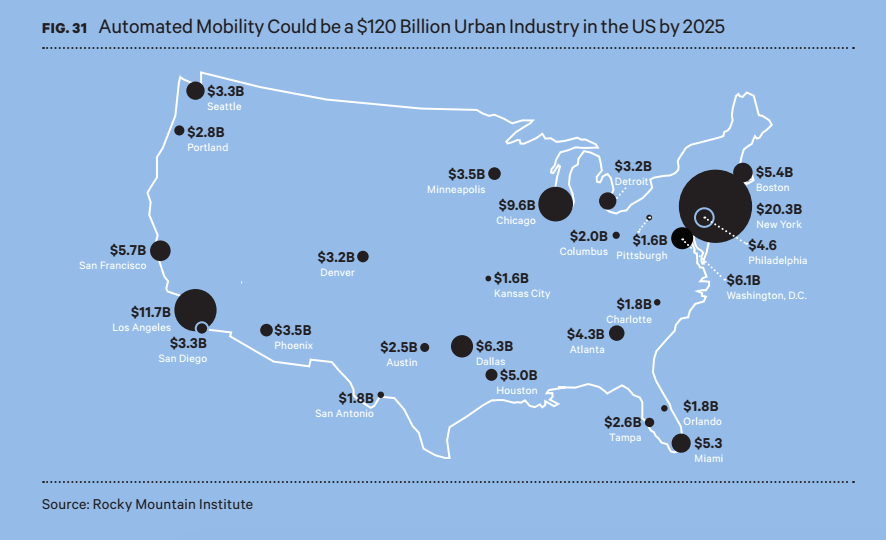
Sustainability
The transition to autonomous vehicles will improve vehicle efficiency and accelerate the shift to clean energy. But these gains could be wasted if precautions are not taken to manage a potential surge in travel. According to a 2014 analysis by the US National Renewable Energy Laboratory, several other advantages — accelerated adoption of electric vehicles, reduction in vehicle weight, smoothing of peak demands for electricity, higher occupancy, and more efficient driving — will all make a greater positive contribution to energy demand.
But just how realistic are these expectations around shared AV taxis? Since 2013, at least five major studies have sought to demonstrate the potential gains from shared AVs in a handful of cities, including New York, Singapore, Lisbon, and Austin. While these studies differ significantly in assumptions and methods, they consistently show that AV ride-sharing is likely to substantially reduce the need for private vehicle ownership. The latest simulation found that when deployed alongside fixed-route mass transit networks, shared-ride AV taxis could all but eliminate the convenience advantage of personal autos.
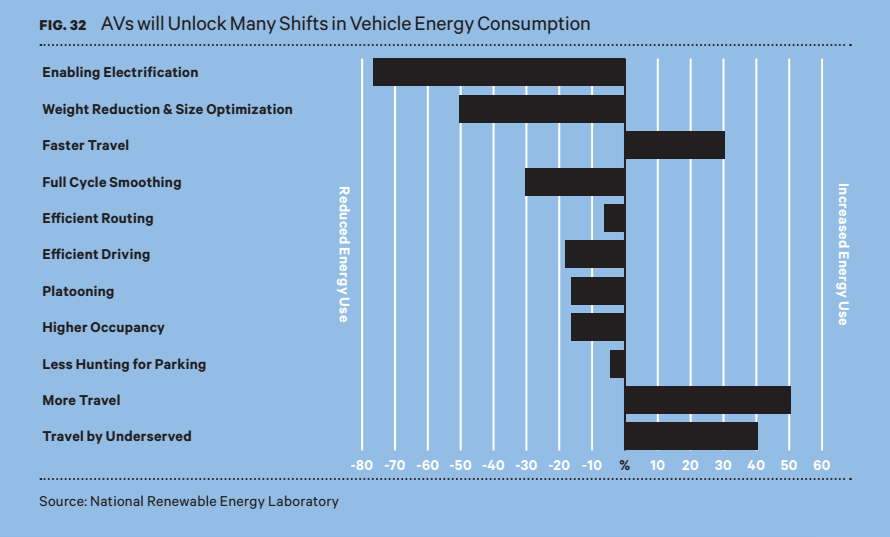
Jobs and the Economy
Fears are mounting about automation’s impact on work and jobs, but AVs could be an essential catalyst for urban economic growth and innovation. In 2016, the average American driver commuted more than 24 minutes each way, up 20 percent since 1980 — a stunning 29.6 billion person-hours of lost time each year, according to the US Census. The Texas Transportation Institute estimates this lost productivity at $160 billion per year in the United States alone. Fears of widespread job loss as driving is automated may affect cities less than expected.
Long-haul trucking is a sector where angst over the downsides of automated driving is high. Some fear that full automation could put as many as 1.7 million drivers out of work. As the same technologies used in long-haul trucking are applied to commercial fleets operating in urban areas, millions of jobs driving buses, delivery vehicles, and school buses will be at risk. The impact of AVs on taxi drivers could be particularly acute, as their numbers have swelled in recent years.
A recent study at Oxford University found that Uber had enabled a 50 percent increase in the number of self-employed taxi drivers in the UK. These jobs are likely to be among the first to disappear. However, Toronto’s 2015 study identified three sectors that could experience potential employment gains of up to 15 percent — construction related to conversion of parking facilities, expansion of highways and roads, and IT products and services directly related to AV rollout.
Indirect positive impacts on employment and overall economic health seem likely, however, as businesses will see the same dramatic drops in transport costs as consumers. AVs will enable the creation of new consumer products and services, contributing to economic growth.
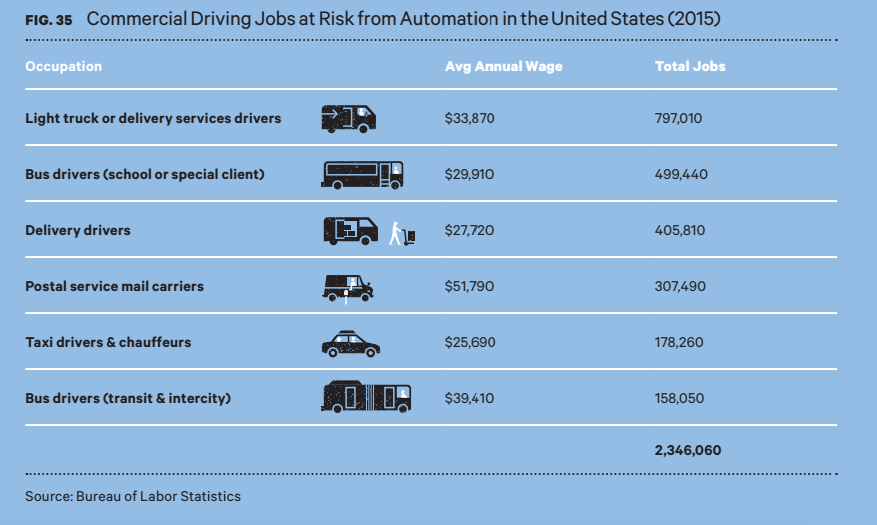
Human Services
Most city governments devote the bulk of their spending to human services. Here, the report looks at two of the most important contributors to well-being and how AVs might enable savings and innovation.
Transportation takes a heavy toll on school spending. In the United States, some 25 million students (nearly 55 percent of those enrolled) are transported by bus at an average cost of more than $960 a year per student. It’s highly uncertain how parents will react to the idea of computers carrying their children to school — but AV buses could substantially reduce these considerable costs for local schools.
In addition to school transport, AVs will affect the way health care is delivered. An estimated 11 million medical appointments are missed annually in the United States due to insufficient transportation. If AVs could fill this gap, an estimated $19 billion could be saved annually, most of it from public-entitlement programs. As AVs become the primary way people access health care, this will create new opportunities to rethink how services are delivered.
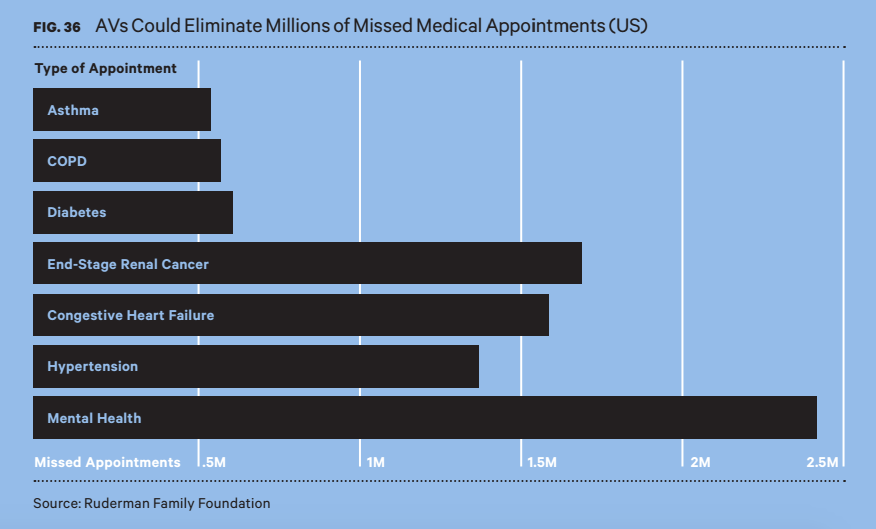
Public Finance
The transition to AVs will decimate many current revenue sources for municipal governments. But it will also allow the creation of targeted taxes and fees that more effectively advance policy goals. The biggest financial opportunity AVs present in cities is in restructuring how road systems are financed. In most countries, motorists pay high taxes on fuel but almost nothing for actual use of roads. This scheme is breaking down all over the world as roads become more congested and widespread electric vehicle use looms.
Land Use
AVs have the potential to further fuel urban sprawl by reducing the inconvenience of long commutes. But they also offer intriguing new possibilities to increase the density and appeal of cities by making them more convenient, safe, and efficient.
Nowhere are the land use impacts of AVs clearer than the dramatic reductions in parking requirements expected in city centers. In Los Angeles, an admittedly extreme case, off-street parking is the dominant land use. Much of this land will be repurposed, as AV-enabled ride-sharing reduces the need for parking. Satellite self-park lots that cater to private AVs may move to less-costly outlying land. What few parking structures remain will be highly automated to increase capacity.
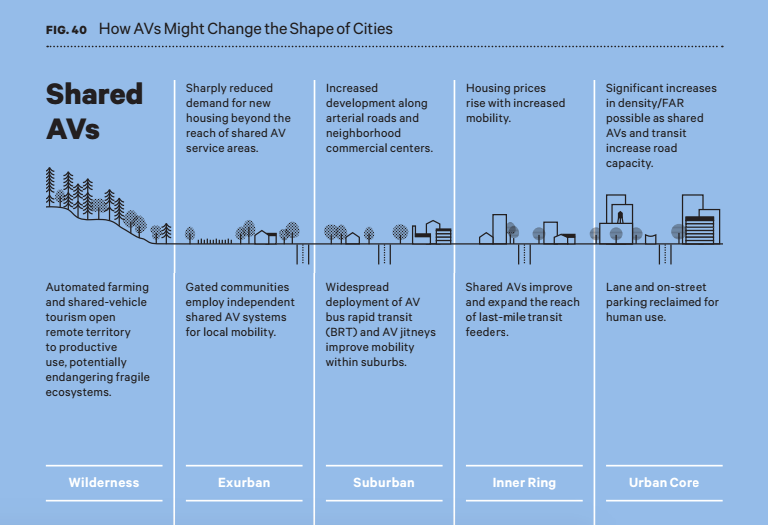
As cities prepare for a more automated future, these seven issues will be on the forefront of policymakers’ minds. For more on how cities can approach these and other AV challenges, you can read the full report.

